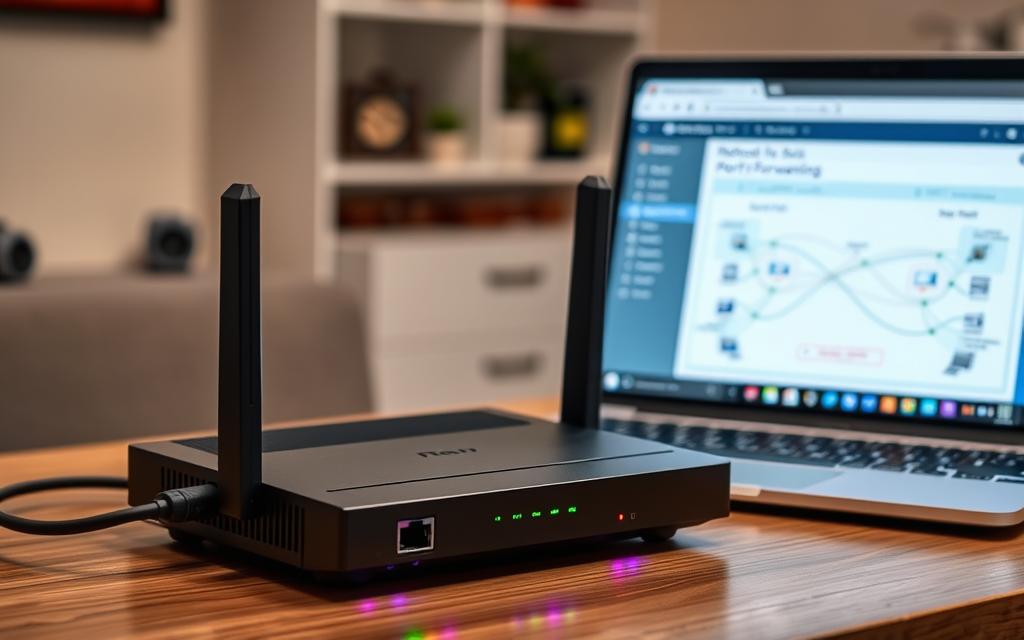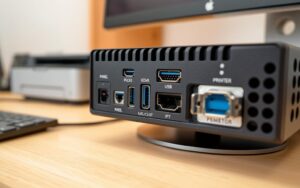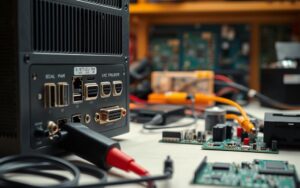Table of Contents
Knowing how port forwarding works is key if you want to get better at managing your network. Especially when it comes to remote access and network security. It lets private network devices connect with outside networks. This helps with things like secure files sharing and allowing internet access to servers.
So, does port forwarding happen on the router or the computer? We’ll look closely at how port forwarding is mainly done through the router. Almost all routers today, around 80-90%, let you set up Port Forwarding or Virtual Server from their settings page.
Understanding port forwarding can change how you manage your network’s resources. For more details, check out this detailed guide. Knowing if the router or computer does port forwarding helps you secure your network and keep it running smoothly.
Understanding Port Forwarding
Understanding port forwarding is vital in today’s network setups. This method organises networking devices. It helps communications between private networks and the internet.
Definition of Port Forwarding
Port forwarding, or mapping, is a network function. It lets external devices talk to specific devices on a local network. By linking a router’s public IP to private IPs, remote computers access internal services. For more details, visit this resource.
How Port Forwarding Works
Port forwarding directs incoming traffic to the right ports on specific devices. In homes, routers manage this, letting users control which traffic gets through. The system uses one of 65,536 virtual ports, but lower numbers see more use. Common application ports include 21 for FTP, 80 for HTTP, and 3389 for Windows Remote Desktop.
It boosts connectivity for games and VoIP, like Minecraft needing port 25565. Yet, security steps like using strong passwords and updating settings are key to safety. For tips on handling ports safely, see this guide.
Is Port Forwarding on Router or Computer?
Understanding port forwarding is key to handling network traffic well. It’s mostly setup on the router. This device connects us to the internet and guides data traffic. Home devices like PCs or game consoles use the router to link with the outside world.
The Role of the Router in Port Forwarding
The router is in charge of directing traffic. It sends data packets between our devices and the internet. In port forwarding, we set ports to guide incoming data to the right device. Each device has its own local IP, like 192.168.0.2, for accurate data delivery.
This careful direction is crucial for things like gaming or remote desktops. Wrong settings can cause connection issues or slow performance.
Can Port Forwarding Be Done on the Computer?
Port forwarding is usually done on the router, but sometimes, computers can play a part. This often involves the computer’s software firewall, not the routing itself. For better internet speeds or specific apps, router access is needed.
Network Utilities software can help. It checks and sets up devices for router-based port forwarding. A permanent IP for these devices helps prevent connection drops.

| Network Component | Primary Function |
|---|---|
| Router | Manages incoming and outgoing data, acts as a gatekeeper |
| Local Devices | Assigned local IPs to receive specific data through forwarded ports |
| Software Firewalls | Can enhance security by controlling access at the device level |
Why is Port Forwarding Important?
Port forwarding is essential for both personal and business use. It improves remote access and boosts network security. By letting outside devices connect to internal services, it opens up many possibilities. At the same time, it keeps the network safe from unwanted access.
Remote Access Capabilities
Port forwarding makes it easy to access services remotely. Users can reach file servers, watch security cameras, or manage smart home tech from afar. This is especially useful for businesses. It lets staff work effectively, even when they’re not in the office.
It’s used in various ways, like linking to IoT devices or running game servers. This shows how versatile port forwarding is.
Enhancing Network Security
Port forwarding isn’t just about remote access; it also secures the network. It allows you to limit access to certain devices. This way, only specific services can be reached from outside.
Turning off UPnP adds to security by keeping more control over open ports. This reduces risk. Using port forwarding wisely stops unauthorized access while keeping needed connections open.
Common Uses of Port Forwarding
Port forwarding is key for smooth communication in different apps and systems. It lets you access systems remotely, back up files, and make game servers and CCTV systems work better. By knowing how port forwarding works, you can make tech more efficient and easier to use.
Backups and File Access
With port forwarding, accessing file backups remotely becomes secure and easy. This feature is crucial for businesses. It ensures that important data is always within reach, no matter where you are. Setting up specific ports makes getting to backups simple and dependable.
Virtual Desktop Infrastructure (VDI)
Port forwarding helps users reach their desktops from afar in a VDI setup. This is great for remote work, letting employees get to their workspaces while on the move or at home. The right setup keeps connections to virtual machines safe, supporting work from anywhere.
Game Servers and Host Access
For gamers, port forwarding is a must for setting up and joining game servers. Some games need open ports, like 27015, for online play. Forwarding these ports makes playing together online smoother, letting players join the host’s game with fewer issues.
CCTV and Remote Security Monitoring
Port forwarding brings big benefits to CCTV systems too. It lets you watch your security cameras over the internet. By setting up forwarding for your cameras’ ports, you can check live feeds anytime. This is great for keeping an eye on your property and spotting trouble early.
Check out detailed guides on how to open specific ports to enhance your network’s functionality.
| Application | Port Number | Benefit |
|---|---|---|
| Backups | Varies | Remote data access |
| VDI | Varies | Remote workspace accessibility |
| Game Servers | 27015 | Improved multiplayer connectivity |
| CCTV | Varies | Remote security monitoring |
How to Enable Port Forwarding on Your Router
Enabling port forwarding helps games and applications work well by sending the internet traffic right to your devices. It means changing some settings on your router. It’s pretty simple if you know what to do.
Accessing Your Router’s Settings
To start, enter your router’s IP address into a web browser. It often looks like 192.168.1.1. Then, log in with the router’s username and password. You might find these on the router or in its manual.
Creating Port Forwarding Rules
Once you’re in, find the port forwarding section. It might be listed as Port Forwarding, Port Triggering, or Applications & Gaming. Here’s how to set up port forwarding:
- Give a fixed IP address to the device needing port forwarding.
- Type in the ports you want to open.
- Choose the protocol: TCP, UDP, or both.
- Hit save and apply your changes.
Testing Your Port Forwarding Setup
After setting up, test to see if port forwarding works. Use online tools or software to check. These tools confirm if the ports are open correctly. If there’s trouble, make sure no firewalls block anything and the IP address is right.
Potential Issues with Port Forwarding
Port forwarding boosts connectivity for many applications. However, it can face several issues. Knowing about double NAT and troubleshooting methods is key to keeping port forwarding working well.
Understanding Double NAT
Double NAT happens with two routers doing Network Address Translation. This makes it hard to connect from outside. Problems with port forwarding come up because the path for communication isn’t clear. Setting your modem to bridge mode might help. This means only one router does the NAT, making things simpler.
Troubleshooting Common Problems
Fixing port forwarding issues means dealing with various challenges. Here’s what you might face and how to solve it:
- Port Conflicts: Different devices or services might want the same port. Make sure every service has its own port.
- Incorrect Protocol Configuration: Wrong TCP or UDP settings can cause trouble. Double-check you have the right settings for your apps.
- Firewall Restrictions: Firewalls might stop the traffic you need for port forwarding. Look at your router and device firewalls to make exceptions.
- Dynamic IPs: If internal or external IP addresses change, your port forwarding might break. Using a static IP or Dynamic DNS could help.
- Multiple Routers: Having more than one router can lead to double NAT. Figure out which is the main router and try to use only one.
- ISP Restrictions: Sometimes ISPs don’t allow port forwarding. If you hit this wall, calling support might help.
Testing your port forwarding setup is crucial. Use online tools and commands like ping or traceroute to find issues. Keeping your router and firewall updated ensures your network stays safe while you use port forwarding.
| Issue | Description | Troubleshooting Steps |
|---|---|---|
| Double NAT | Two routers performing NAT, complicating connections | Configure modem in bridge mode |
| Port Conflicts | Multiple devices/services using the same port | Assign unique ports for each service |
| Firewall Blocks | Incoming traffic blocked by firewall settings | Adjust firewall settings to allow traffic |
| Dynamic IPs | IP address changes can disrupt port forwarding | Use static IP addresses for devices |
| ISP Limitations | Restrictions on your service provider’s end | Contact ISP for port forwarding permissions |
Conclusion
Port forwarding is a key technique in networking, used mostly through routers. It helps local networks connect to the vast internet easily. By assigning specific ports, it allows different devices or apps to link up. Understanding the role of routers compared to computers shows the depth of this important process. It shows that routers are crucial for managing data that comes in or goes out.
This technique is vital for many uses like online gaming and working remotely. By learning good networking strategies, users can make the most of their resources. They become more efficient and safe. But, opening ports can make networks vulnerable to attacks. So, being aware of security risks is essential.
Using port forwarding wisely can boost connectivity and make networks safer. It’s great for things like home automation and IoT devices. This article gives valuable insights for anyone wanting to up their tech game. It helps them stay safe while making full use of their network’s capabilities.
FAQ
What is port forwarding?
Port forwarding, also called port mapping, is a way for devices on a private network to talk to devices on the internet. It links a device’s private IP address to a router’s public IP address. This makes the connection possible.
How does port forwarding work?
Port forwarding redirects incoming traffic on the router’s public IP to a device inside the local network. It uses designated ports for this. This makes connections with internal services possible for external devices.
Is port forwarding done on the router or the computer?
It’s mainly set up on the router. The router manages the data flow between inside and outside networks. Some software might have client-side settings, but the router handles the main settings.
What are the benefits of port forwarding?
Port forwarding boosts remote access. It lets you reach services like file servers from anywhere. It’s great for online gaming, remote CCTV, and accessing VDI solutions too.
What is Double NAT and how does it affect port forwarding?
Double NAT happens when two routers on a network both do NAT. It makes port forwarding tough. External devices may not reach local services easily. Setting the modem to bridge mode can solve this.
How do I enable port forwarding on my router?
To start, log into your router through a web browser with the router’s IP address. Use the router’s username and password. Then, go to the port forwarding section to create rules that guide traffic to the right device.
What common problems might I encounter with port forwarding?
You might face issues like Double NAT, wrong router settings, or firewalls blocking your traffic. To fix these, check your router and device settings. Make sure the right ports are open.









